The Ring Nebula is a bright planetary nebula located approximately 2,567 light-years away in the constellation Lyra. With an apparent magnitude of 8.8, it is one of the brightest planetary nebulae in the sky, easily observed in a small telescope. The nebula appears south of Vega. It has the designation Messier 57 (M57) in the Messier catalogue and is listed as NGC 6720 in the New General Catalogue.
Like all planetary nebulae, the Ring Nebula was formed when an evolved red giant star expelled its outer envelope of ionized gas into space. As the clouds of ejected material expand into the interstellar medium, they are energized by the ultraviolet light of the hot stellar remnant that will soon cool and fade as a white dwarf.
The Ring Nebula has three distinct regions: the central cavity, the bright shell, and the halo. The central cavity appears spherical and has a radius of about 25 arcseconds. It has a linear structure that appears as two brighter stripes on either side of the progenitor star.
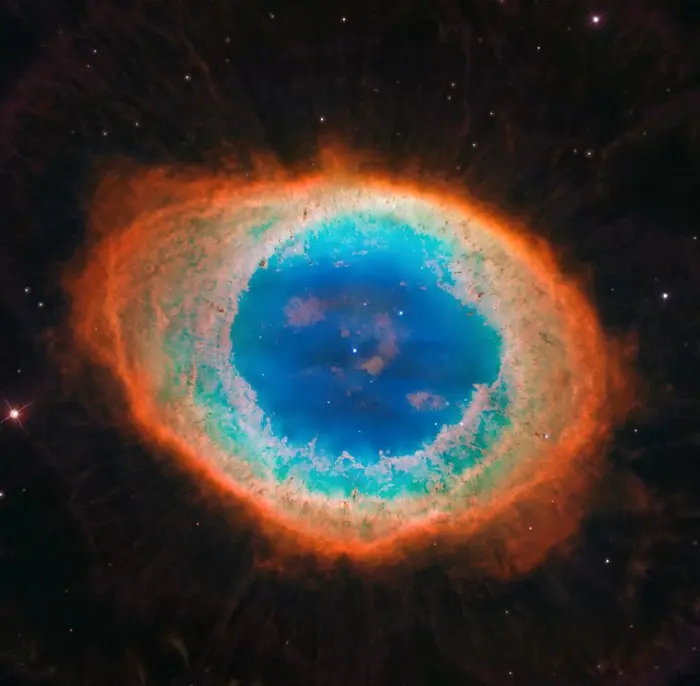
The Ring Nebula (NGC 6720), image credit: Credit: NASA/ESA HST, Spitzer ST, Giuseppe Donatiello (CC0 1.0)
The bright shell surrounding the central cavity has an elliptical shape. It has an outer radius of 44 arcseconds along the major axis and 35 arcseconds along the minor axis. It appears much brighter along the minor axis. The outer edge of the bright shell is distorted towards the northeast, which roughly corresponds to the direction of the central star’s proper motion. The distortion may be a result of interaction with the surrounding interstellar medium.
The central star does not appear in the centre of the cavity. It is offset to the north-west by 2 arcseconds. The offset may be related to the star’s multiplicity. The progenitor has two companions.
The nebula’s halo has a complex structure that includes around 10 concentric arcs, 400 spikes, and distorted edges. Unlike the bright shell, it is not easily observed in amateur telescopes.
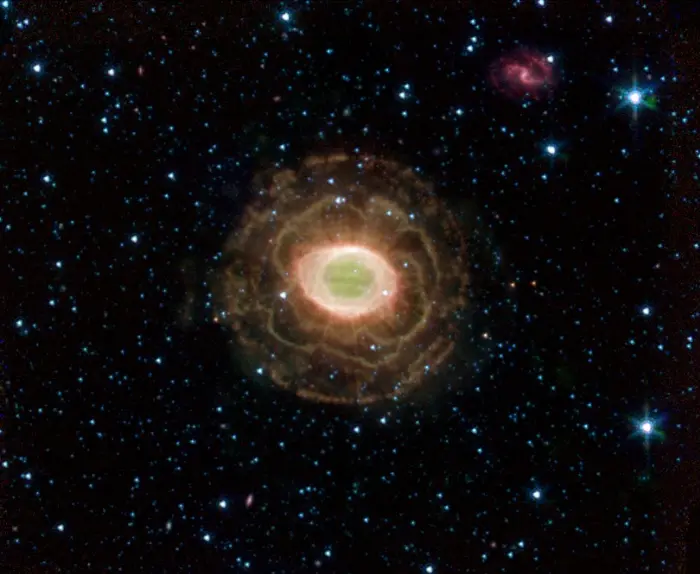
NASA’s Spitzer Space Telescope finds a delicate flower in the Ring Nebula, as shown in this image. The outer shell of this planetary nebula looks surprisingly similar to the delicate petals of a camellia blossom. The “ring” is a thick cylinder of glowing gas and dust around the doomed star. As the star begins to run out of fuel, its core becomes smaller and hotter, boiling off its outer layers. The telescope’s infrared array camera detected this material expelled from the withering star. Previous images of the Ring Nebula taken by visible-light telescopes usually showed just the inner glowing loop of gas around the star. The outer regions are especially prominent in this image because Spitzer sees the infrared light from hydrogen molecules. The molecules emit infrared light because they have absorbed ultraviolet radiation from the star or have been heated by the wind from the star. Image credit: NASA/JPL-Caltech/J. Hora (Harvard-Smithsonian CfA)
The Ring Nebula has a visual magnitude of 8.8 and a photographic magnitude of 9.7. It is one of the brightest planetary nebulae in the sky, along with the Dumbbell Nebula (M27) in Vulpecula, the Helix Nebula (NGC 7293) and the Saturn Nebula (NGC 7009) in Aquarius, the Ghost of Jupiter (NGC 3242) in Hydra, and the Blue Planetary Nebula (NGC 3918) in Centaurus.
Planetary nebulae form in the late evolutionary stages of intermediate-mass stars like the Sun. Late-stage asymptotic giant branch stars produce an extended atmosphere through a slow wind. As the stars start to quickly increase in temperature, the stellar wind becomes faster, producing a molecule-rich outer zone. The fast wind sweeps up material in the inner zone. The density of gas decreases as the nebula’s shell expands.
Once the central stars become less luminous, the fast stellar wind stops, and the innermost regions of the nebulae become more complex and may be filled with backflowing material.
Planetary nebulae like M57 show the fate our own Sun in the distant future. They are the final chapters of a star similar to the Sun in mass, which expels its outer layers to form complex structures before slowly cooling and becoming a white dwarf. The clouds of gas that form planetary nebulae dissipate within only around 10,000 years, making these objects relatively short-lived cosmic events.
Planetary nebulae are believed to play an important role in the evolution of galaxies. Newly formed stars are composed almost entirely of hydrogen and helium. As they evolve, the stars produce heavier elements via nuclear fusion. These elements, such as carbon, oxygen and nitrogen, are eventually expelled through powerful stellar winds as the stars go through the asymptotic giant branch (AGB) phase. The elements (known as metals by astronomers) are then recycled into the interstellar medium, where they enrich the cosmos and are incorporated into new generations of stars. The stars formed in these enriched regions have higher metallicities.
The Ring Nebula is believed to be expanding for around 1,610 ± 240 years. The central star has left the asymptotic giant branch (AGB) within the last 2,000 years and is now evolving into a white dwarf. It is composed mostly of carbon and oxygen. Its outer envelope consists of lighter elements.
The different chemicals emit light of specific colours, resulting in the nebula’s colourful appearance. Long-exposure photographs help astronomers study the chemical makeup of the gas and the evolution of nebulae in great detail.
The Ring Nebula has an apparent size of 1.5 arcminutes. Its elliptical ring is visible in small telescopes, but the central star is a more challenging target. The brighter inner halo is 160 by 146 arcseconds in diameter while the fainter outer halo is about 230 arcseconds across.
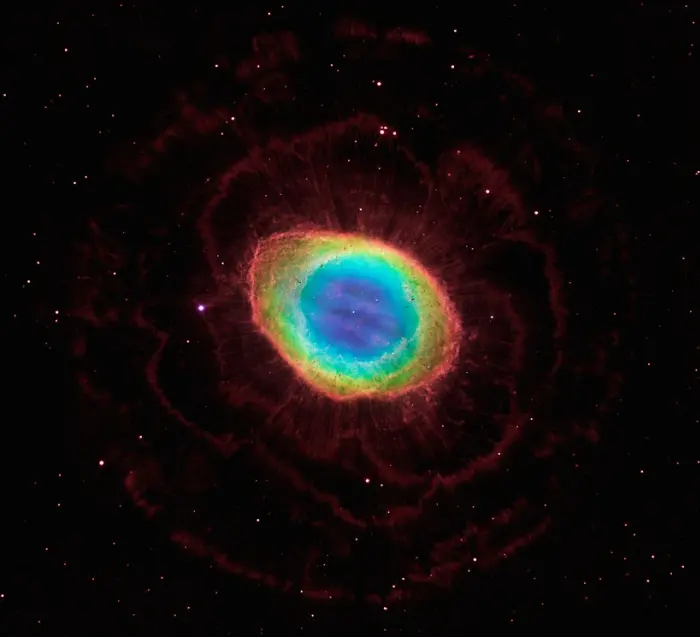
In this composite image, visible-light observations by NASA’s Hubble Space Telescope are combined with infrared data from the ground-based Large Binocular Telescope in Arizona to assemble a dramatic view of the well-known Ring Nebula. Image credit: NASA, ESA, C.R. Robert O’Dell (Vanderbilt University), G.J. Ferland (University of Kentucky), W.J. Henney and M. Peimbert (National Autonomous University of Mexico); credit for Large Binocular Telescope data: David Thompson (University of Arizona)
The inner halo is elongated along the nebula’s apparent major axis, while the outer halo is knotty and irregular, but appears almost circular. The outer rings of M57 were formed when faster-moving gas collided with the slower-moving material. A 1997 study found that the halos of M57 have similar kinematical properties and chemical abundances. Astronomers believe that they both have an origin in the slow AGB wind.
M57 is classified as a bipolar planetary nebula. It has a prolate spheroid shape. The nebula’s axis of symmetry is tilted at about 30 degrees when seen from Earth.
The nebula’s main shell is a triaxial ellipsoid seen almost exactly pole-on. The inner region of the nebula appears blue-green in images. The blue-green tinge is produced by the doubly ionized oxygen emission lines (“forbidden lines”), which occur only in low-density regions. The reddish glow in the nebula’s outer ring is caused by hydrogen emission.
The inner halo is ionized by Lyman continuum photons (LyC photons), photons emitted by the central star at an energy above the Lyman limit. The nebula’s hydrogen is ionized by absorbing these protons at specific wavelengths.
The LyC protons are escaping through the main nebula’s poles. Meanwhile, the outer envelope shows fossil emission from an earlier phase, when the central star was more luminous.
The central star of the Ring Nebula is catalogued as HD 175353. It has a visual magnitude of 15.75. A 2007 study led by C. R. O’Dell (Department of Physics and Astronomy, Vanderbilt University, Nashville, TN) found a temperature of 125,000 ± 5,000 K and a mass of 0.61-0.62 solar masses for the star. The star is currently 200 – 300 times more luminous than the Sun, but will eventually cool and fade.
Images captured over a period of 50 years have revealed an expansion rate of around 1 arcsecond per century for the nebula, or 20-30 km/s.
The Ring Nebula has an estimated age of 7,000 years. It is in a late stage for planetary nebulae, when the time scale of the luminosity fading of the central star has exceeded the timescale of the nebula’s expansion.
James Webb Space Telescope (JWST) images
The Ring Nebula was imaged by NASA and ESA’s James Webb Space Telescope (JWST) in August 2022. A composite image of the nebula, obtained using three different filters, was released in August 2023. The high-resolution images of M57 were captured by Webb’s Near-Infrared Camera (NIRCam) and Mid-Infrared Instrument (MIRI).
The Webb image taken by NIRCam was released by an international team of astronomers in the JWST Ring Nebula Imaging Project, including Mike Barlow at University College London, Nick Cox of ACRI-ST (France), Albert Zijlstra of the University of Manchester, and Jan Cami, Els Peeters and Nicholas Clark of the Western University’s Institute for Earth and Space Exploration.
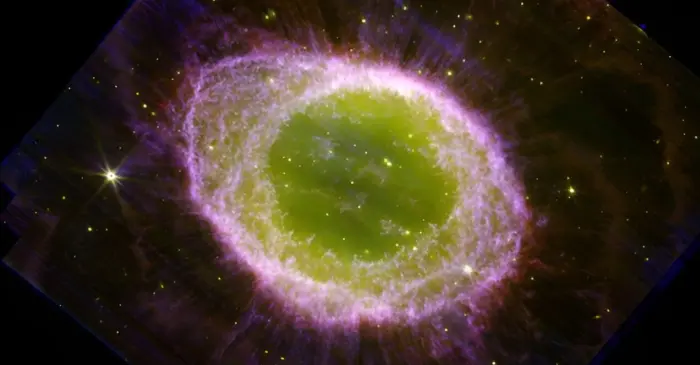
JWST/NIRcam composite image of the Ring Nebula. The image was obtained with JWST’s NIRCam instrument on August 4, 2022. Images in three different filters were combined to create this composite image: F212N (blue); F300M (green); and F335M (red). Image credit: NASA / ESA / CSA / JWST Ring Nebula Team / Roger Wesson
Webb observations have revealed the intricate details of the nebula in unprecedented detail. They provide scientists with new insights into the processes of stellar evolution and the life cycles of stars, as well as into the nebula’s doughnut-shaped morphology and the complex processes that shaped the nebula’s glowing gas. The images will help astronomers understand how a star’s gaseous envelope becomes a mixture of simple and complex molecules and dust grains.
Astronomers plan to obtain more MIRI images of the nebula, which will reveal more structural details.
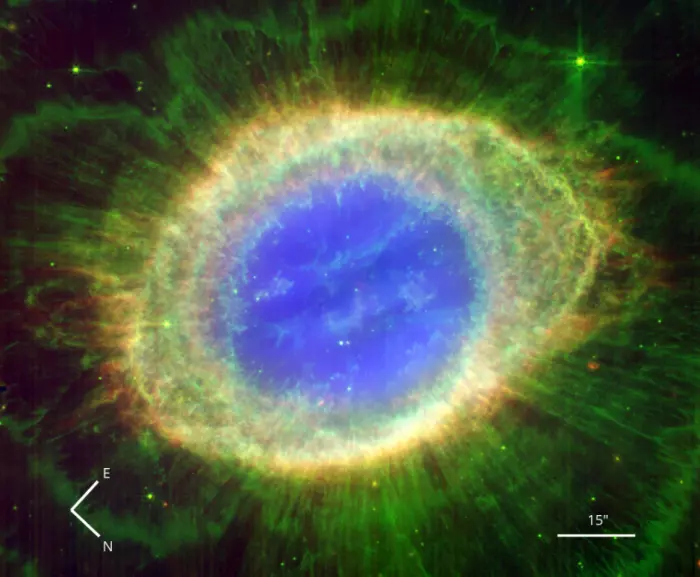
MIRI three-colour image of the Ring Nebula: F2550W (blue), F560W (green) and F1130W (red). Image credit: NASA / ESA / CSA / JWST Ring Nebula Team / Roger Wesson
A 2023 study analyzing the JWST images of the Ring Nebula reported around 20,000 dense globules with an average diameter of 0.2 arcseconds in the nebula’s bright shell. The team, led by Roger Wesson at the Cardiff Hub for Astrophysics Research and Technology (CHART), found that the shell contains a thin ring of a class of organic compounds known as polycyclic aromatic hydrocarbons (PAHs). PAHs, an essential component of organic matter in space, were previously detected in the Ring Nebula by the Spitzer’s Infrared Spectrograph (IRS) in 2016.
The nebula contains hydrogen (H2) throughout the shell and in the halo. The central cavity is filled with high ionization gas and contains two linear structures. Spikes extend outward from the nebula’s ring and point away from the progenitor star.
The team found about 10 concentric arcs that indicate orbital modulation by a low-mass companion. The orbit has a period of around 280 years and a semi-major axis of 50 astronomical units for an assumed combined mass of 1.5 solar masses.
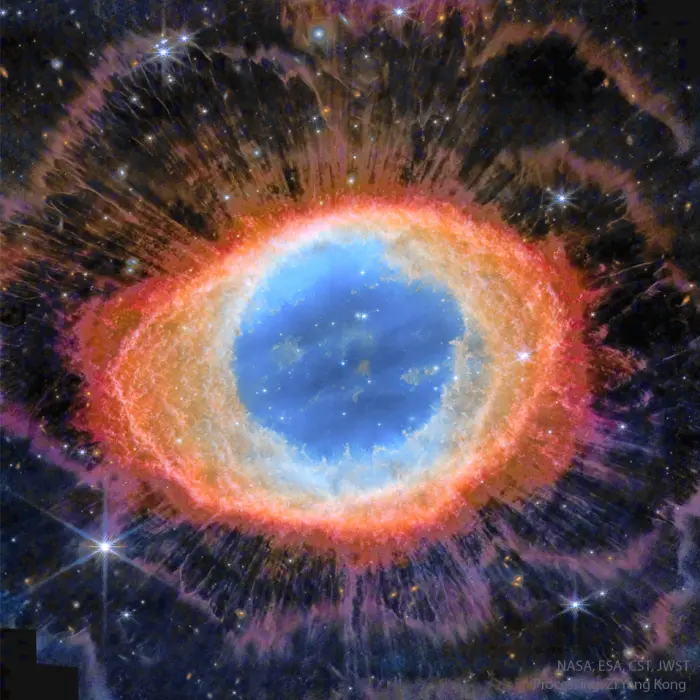
The Ring Nebula (M57) as seen in infrared by the James Webb Space Telescope, showing an outer layer of hydrogen that cannot be seen in visible light. Image credit: NASA, ESA, CSA, JWST; Processing: Zi Yang Kong
A wider companion is separated from the central star by about 15,000 astronomical units, or 18.5 arcseconds. The star was identified in 2021 and has the Gaia catalogue designation Gaia DR3 2090486687506009472. It shares the proper motion and parallax with the Ring Nebula’s central star. The JWST’s observations showed that the star was a dwarf of the spectral type M2-M4.
The JWST team found that the features seen in the Ring Nebula were similar to those seen in its southern counterpart, the Southern Ring Nebula (NGC 3132), imaged by Webb in 2022. The astronomers concluded that these features, including the multiplicity of the central star, may be common to such planetary nebulae.
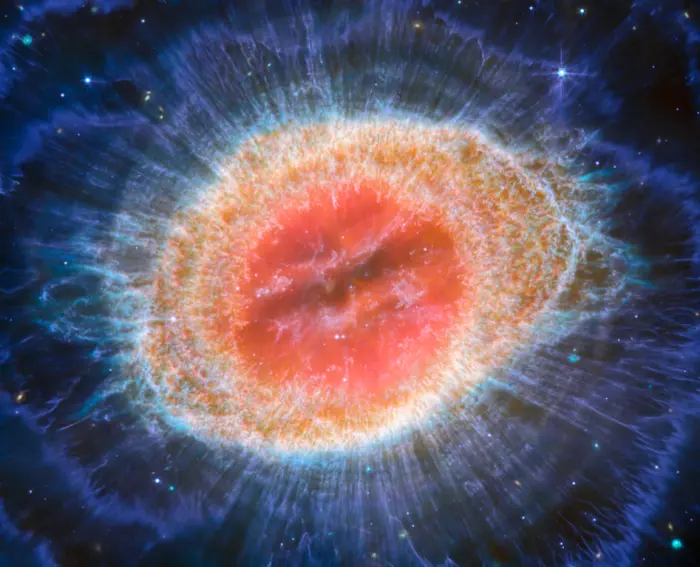
NASA’s James Webb Space Telescope has observed the well-known Ring Nebula with unprecedented detail. Formed by a star throwing off its outer layers as it runs out of fuel, the Ring Nebula is an archetypal planetary nebula. Also known as M57 and NGC 6720, it is relatively close to Earth at roughly 2,500 light-years away.
This new image provides unprecedented spatial resolution and spectral sensitivity. In particular, Webb’s MIRI (Mid-InfraRed Instrument) reveals particular details in the concentric features in the outer regions of the nebula’s ring. There are some 20,000 dense globules in the nebula, which are rich in molecular hydrogen. In contrast, the inner region shows very hot gas. The main shell contains a thin ring of enhanced emission from carbon-based molecules known as polycyclic aromatic hydrocarbons (PAHs). Roughly ten concentric arcs located just beyond the outer edge of the main ring. The arcs are thought to originate from the interaction of the central star with a low-mass companion orbiting at a distance comparable to that between the Earth and Pluto. In this way, nebulae like the Ring Nebula reveal a kind of astronomical archaeology, as astronomers study the nebula to learn about the star that created it. Image credit: ESA/Webb, NASA, CSA, M. Barlow (UCL), N. Cox (ACRI-ST), R. Wesson (Cardiff University)
The Southern Ring Nebula lies at a similar distance and also exhibits many globules visible in H2, a system of concentric arcs, radial spikes in the halo, and a structure inside the central cavity. Interestingly, the Ring Nebula, the Southern Ring Nebula, and the Helix Nebula (another nebula with a similar appearance) all have around 20,000 globules, but there are differences in the shape and size of these globules. The globules in the Helix are larger than those in M57 and have tails. This may be because the Helix Nebula is more evolved than the Ring.
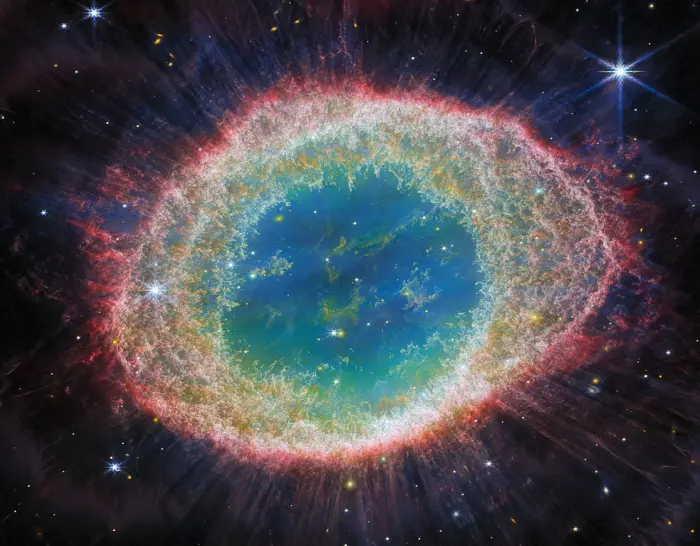
The NASA/ESA/CSA James Webb Space Telescope has observed the well-known Ring Nebula with unprecedented detail. Formed by a star throwing off its outer layers as it runs out of fuel, the Ring Nebula is an archetypal planetary nebula. Also known as M57 and NGC 6720, it is both relatively close to Earth at roughly 2,500 light-years away. This new image provides unprecedented spatial resolution and spectral sensitivity. For example, the intricate details of the filament structure of the inner ring are particularly visible in this dataset. There are some 20,000 dense globules in the nebula, which are rich in molecular hydrogen. In contrast, the inner region shows very hot gas. The main shell contains a thin ring of enhanced emission from carbon-based molecules known as polycyclic aromatic hydrocarbons (PAHs). Roughly ten concentric arcs are located just beyond the outer edge of the main ring. Image credit: ESA/Webb, NASA, CSA, M. Barlow, N. Cox, R. Wesson (CC BY 4.0)
Facts
The Ring Nebula was discovered by the French astronomer and comet hunter Charles Messier in January 1779. Messier catalogued the object as Messier 57 in his catalogue of bright deep sky objects that may be mistaken for comets.
French astronomer Antoine Darquier de Pellepoix independently discovered the nebula from Toulouse two weeks later while following Comet Bode. Darquier described the object as “as large as Jupiter and resembles a planet which is fading.”
Charles Messier and his contemporary, the German-born British astronomer William Herschel both proposed that the nebula consisted of multiple faint stars that could not be resolved in their telescopes.
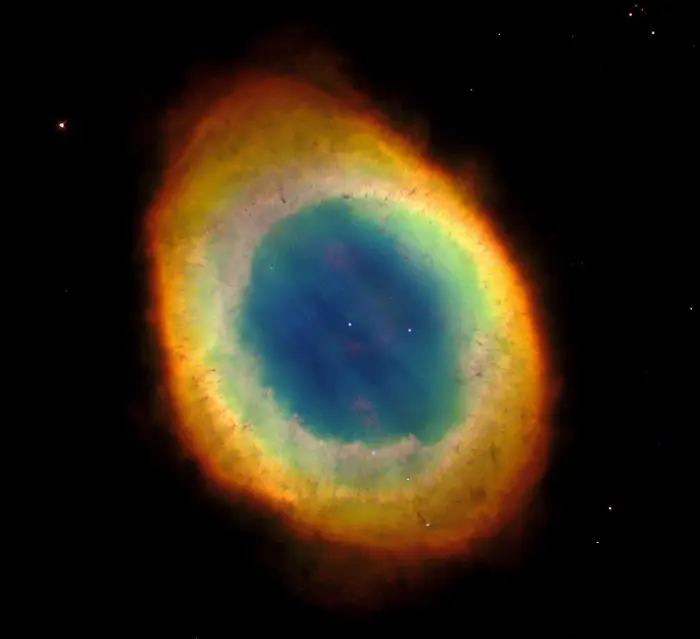
NASA’s Hubble Space Telescope has captured the most famous of all planetary nebulae: the Ring Nebula (M57). In this October 1998 image, the telescope has looked down a barrel of gas cast off by the central star thousands of years ago. This photo reveals elongated dark clumps of material embedded in the gas at the edge of the nebula; the central star floating in a blue haze of hot gas. Image credit: The Hubble Heritage Team (AURA/STScI/NASA)
German astronomer and philosopher Friedrich von Hahn observed the nebula in a 12″ reflector before 1800 and spotted the central star. In 1800, he wrote, “In the famous star-ring near β Lyrae I find distinct changes. A few years ago the interior of the ring was so clear that I could distinguish in its centre a telescopic star with my 20ft reflector. Now this telescope shows only faint fine clouds and the small star is no longer visible.”
In 1842, French mathematician, physicist and astronomer François Arago of the Paris Observatory proposed that the central star illuminates the nebula, which would explain the nebula’s uniform light.
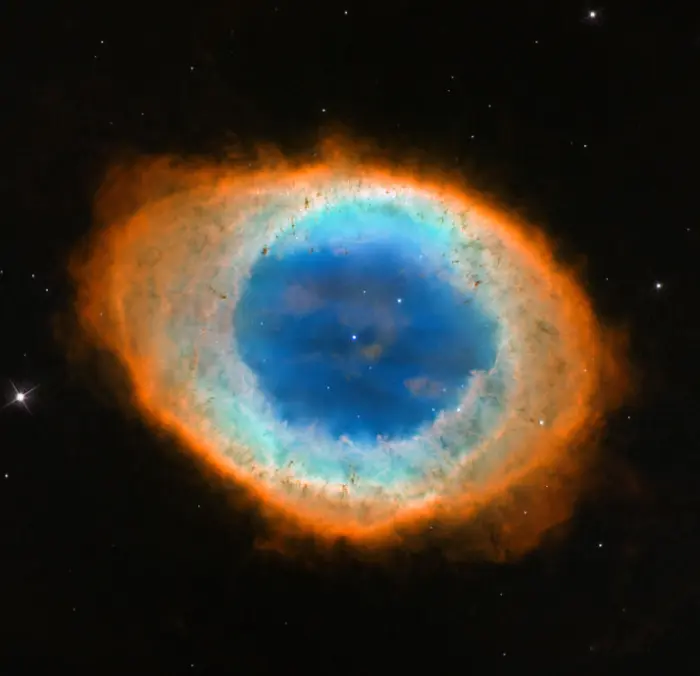
Ring Nebula captured by the Hubble Space Telescope in 2013, image credit: NASA, ESA, and C. Robert O’Dell (Vanderbilt University)
The central star was photographed for the first time on September 1, 1886, when Hungarian astronomer Eugene von Gothard captured it with a 10.25″ Browning reflector from Herény, Hungary.
In 1864, English astronomer and astronomical spectroscopy pioneer William Huggins, analyzed the spectra of M57, the Cat’s Eye Nebula (NGC 6543) and other nebulae, and found that some of them showed bright emission lines, indicating fluorescing glowing gases.
Based on this finding, Huggins concluded that most planetary nebulae did not consist of unresolved stars, but that they were in fact nebulae. Other nebulae observed by Huggins include the Dumbbell Nebula (M27) in the constellation Vulpecula, the Emerald Nebula (NGC 6572) in Ophiuchus, the Blinking Planetary Nebula (NGC 6826) in Cygnus, the Little Gem Nebula (NGC 6818) in Sagittarius, the Saturn Nebula (NGC 7009) in Aquarius, and the Blue Snowball Nebula (NGC 7662) in Andromeda.
The Ring Nebula appears in the same wide field of view as the galaxy IC 1296. The faint galaxy has a visual magnitude of 15.5 and appears face-on. It lies within 4 arcminutes of NGC 6720.
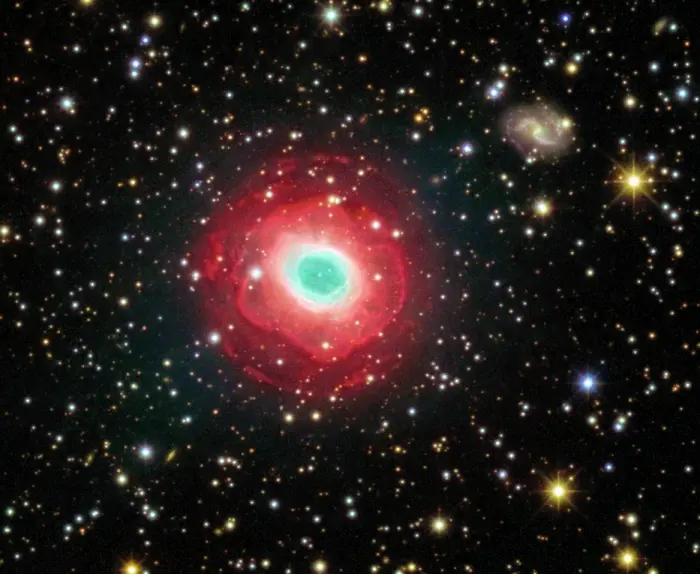
The Ring Nebula (Messier 57) and the galaxy IC 1296, image credit: Domenico Argentiero, Giuseppe Donatiello, Terenzio Fusco, Federico Lavarino, Colin McGill, Alessandro Elio Milani (CC0 1.0)
Messier 57 shares its name with the Ring Nebula (Hubble 1925 III) in Barnard’s Galaxy (NGC 6822, Caldwell 57), located in the constellation Sagittarius. NGC 6822 contains regions of bright emission nebulosity. It appears southeast of the Bubble Nebula (Hubble 1925 I), which also has a better-known namesake (NGC 7635) in the constellation Cassiopeia.
The Ring Nebula appears very similar to the Helix Nebula (NGC 7293) in images. Nicknamed the Eye of God, the Helix Nebula is much closer to us. It lies around 650 light-years away in the constellation Aquarius. With an apparent magnitude of 7.6 and an angular size of 25 arcminutes, the Helix appears brighter than the Ring Nebula, but is not as easily found because it appears in a fainter area of the sky. The Ring Nebula is considered a younger sibling of the larger Helix. Like M57, the Helix has a system of globules, but the globules in the nebula’s inner shell have well-defined tails, which is not the case with those in M57.
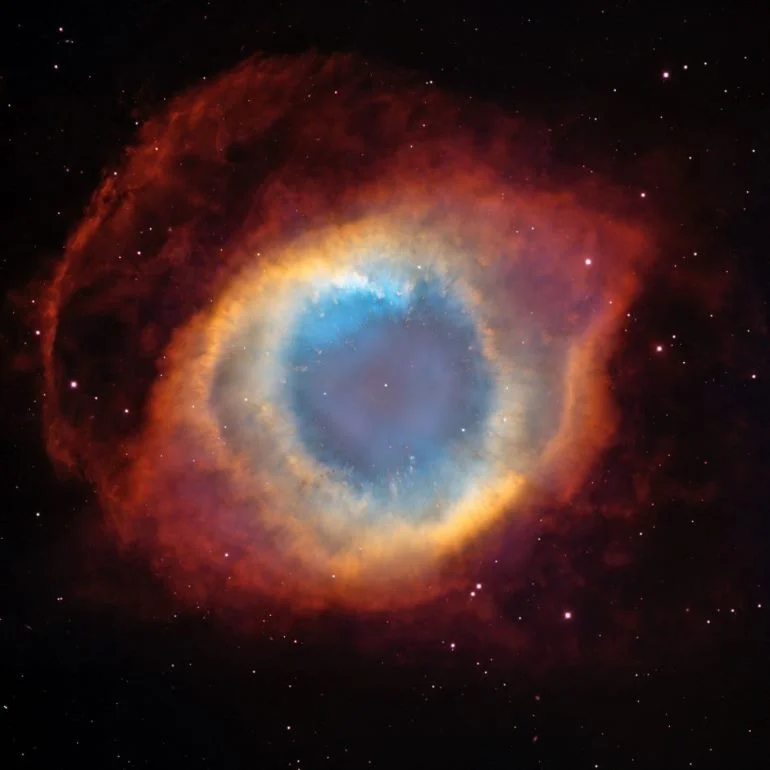
Helix Nebula, image: NASA, ESA, and C.R. O’Dell (Vanderbilt University)
Location
The Ring Nebula is very easy to find because it lies in the same area as Vega, the fifth brightest star in the sky. Vega is the northwestern star of the Summer Triangle, an asterism also formed by Deneb in Cygnus and Altair in Aquila. The Summer Triangle is visible high overhead in the summer months for observers in the northern hemisphere.
Vega lies near a faint parallelogram pattern that forms the body of the celestial Harp. The Ring Nebula appears between Sheliak (Beta Lyrae) and Sulafat (Gamma Lyrae), the stars at the base of the parallelogram. The nebula lies about 40% of the way from Sheliak to Sulafat.
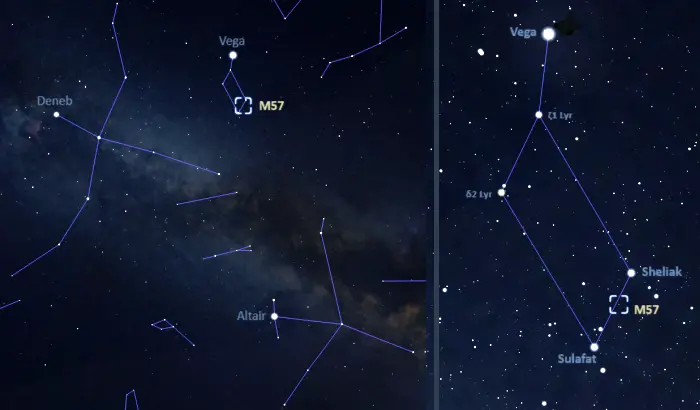
The location of the Ring Nebula (M57), image: Stellarium
Messier 57 is one of the most popular targets for amateur astronomers. It can be spotted in a 3-inch telescope, but is best observed in 8-inch and larger instruments with UHC or OIII filters.
The nebula’s elliptical shape can be seen in small telescopes and its central hole is resolved in 4-inch telescopes at a magnification of 100x. Larger telescopes reveal details on the edges of the ring, as well as the faint nebulosity inside the nebula’s disk.
The best time of the year to observe the Ring Nebula and other deep sky objects in Lyra is during the month of August, when the constellation climbs high above the horizon in the evening. At declination +33° 01’, the nebula is visible from locations north of the latitude 57° S.
Ring Nebula – Messier 57
| Constellation | Lyra |
| Right ascension | 18h 53m 35.0967659112s |
| Declination | +33° 01′ 44.883287544″ |
| Apparent magnitude | 8.8 |
| Apparent size | 230″ × 230″ |
| Distance | 2,567 ± 115 light-years (787 ± 35 parsecs) |
| Radius | 1.3 light-years (0.9 – 2.1 ly) |
| Names and designations | Ring Nebula, Messier 57, M57, NGC 6720, PN G063.1+13.9, PK 063+13, ARO 9, VV 214, VV’ 466, NVSS J185335+330145, IRAS 18517+3257, HD 175353, GC 4447, BD+32 3246, GCRV 11366, PLX 4377.00, WD 1851+329, WEB 16043, Gaia DR2 2090486618786534784, Gaia DR3 2090486618786534784 |